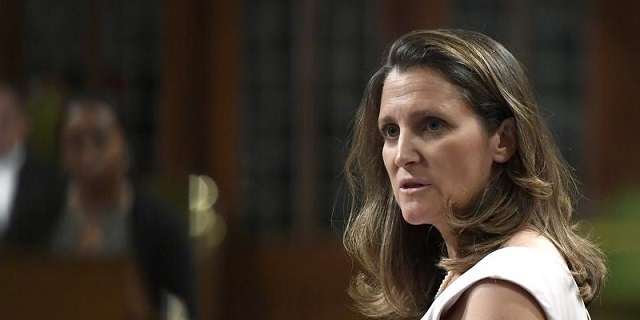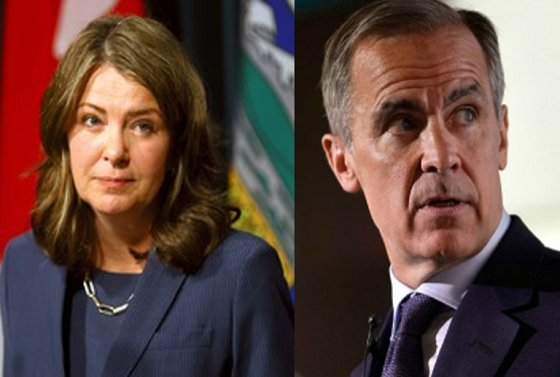Business
Capital gains tax hike will cause widespread damage in Canadian economy

From the Fraser Institute
By Jake Fuss and Grady Munro
According to an analysis by economist Jack Mintz, 50 per cent of taxpayers who claim more than $250,000 of capital gains in a year earned less than $117,592 in normal annual income from 2011 to 2021. These include individuals with modest annual incomes who own businesses, second homes or stocks, and who may choose to sell those assets once or infrequently in their lifetimes (such as at retirement)
On Monday, two months after tabling the federal budget, Finance Minister Chrystia Freeland introduced a motion in Parliament to increase taxes on capital gains. On Tuesday, the motion passed as the NDP, Bloc Québécois and Green Party voted with the Liberals. Unfortunately for Canadians, the tax hike will likely hurt Canada’s economy. And the finance minister continues to make misleading claims to defend it.
Currently, investors who sell capital assets pay taxes on 50 per cent of the gain (based on their highest marginal tax rate). On June 25, thanks to Freeland’s motion, that share will increase to 66.7 per cent for capital gains above $250,000. (Critically, the gain includes inflationary and real increases in the value of the asset.)
According to Minister Freeland, the hike is necessary because it will bring in more than $19 billion of revenue over five years to pay for new spending on housing, national defence and other programs. This claim is disingenuous for two reasons.
First, investors do not pay capital gains taxes until they sell assets and realize gains. A higher capital gains tax rate gives them an incentive to hold onto their investments, perhaps anticipating that a future government may reduce the rate. Individuals and businesses may not sell their assets as quickly as the government anticipates so the tax hike ends up generating less revenue than expected.
Second, the government does not have a revenue problem. Annual federal revenue is increasing and has grown (nominally) more than $185 billion (or 66.2 per cent) from 2014-15 to 2023-24. Before tabling the budget in April, the government was already anticipating annual revenue to increase by more than $27 billion this year. But the government has chosen to spend every dime it takes in (and then some) instead of being disciplined.
Years of unrestrained spending and borrowing have led to a precarious fiscal situation in Ottawa. If the government wanted to pay for new programs, it could’ve reduced spending in other areas. But Minister Freeland largely chose not to do this and sought new revenue tools after realizing this year’s deficit was on track to surpass her fiscal targets. Clearly, raising taxes to generate revenue was unnecessary and could’ve been avoided with more disciplined spending.
Further misleading Canadians, the Trudeau government claims this tax hike will only increase taxes for “0.13 per cent of Canadians.” But in reality, many Canadians earning modest incomes will pay capital gains taxes.
According to an analysis by economist Jack Mintz, 50 per cent of taxpayers who claim more than $250,000 of capital gains in a year earned less than $117,592 in normal annual income from 2011 to 2021. These include individuals with modest annual incomes who own businesses, second homes or stocks, and who may choose to sell those assets once or infrequently in their lifetimes (such as at retirement). Contrary to the government’s claims, the capital gains tax hike will affect 4.74 million investors in Canadian companies (or 15.8 per cent of all tax filers).
In sum, many Canadians who you wouldn’t consider among “the wealthiest” will earn capital gains exceeding $250,000 following the sale of their assets, and be impacted by Freeland’s hike.
Finally, the capital gains tax hike will also inhibit economic growth during a time when Canadians are seeing a historic decline in living standards. Capital gains taxes discourage entrepreneurship and business investment. By raising capital gains taxes the Trudeau government is reducing the return that entrepreneurs and investors can expect from starting a business or investing in the Canadian economy. This means that potential entrepreneurs or investors are more likely to take their ideas and money elsewhere, and Canadians will continue to suffer the consequences of a stagnating economy.
If Minister Freeland and the Trudeau government want to pave a path to widespread prosperity for Canadians, they should reverse their tax hike on capital gains.
Authors:
Business
Storm clouds of uncertainty as BC courts deal another blow to industry and investment

From the Fraser Institute
By Tegan Hill and Jason Clemens
Recent court decision adds to growing uncertainty in B.C.
A recent decision by the B.C. Court of Appeal further clouds private property rights and undermines investment in the province. Specifically, the court determined British Columbia’s mineral claims system did not follow the province’s Declaration on the Rights of Indigenous Peoples Act (DRIPA), which incorporated the United Nations Declaration on the Rights of Indigenous Peoples (UNDRIP) into law.
DRIPA (2019) requires the B.C. provincial government to “take all measures necessary to ensure the laws of British Columbia are consistent with the Declaration,” meaning that all legislation in B.C. must conform to the principles outlined in the UNDRIP, which states that “Indigenous peoples have the right to the lands, territories and resources which they have traditionally owned, occupied or otherwise used or acquired.” The court’s ruling that the provincial government is not abiding by its own legislation (DRIPA) is the latest hit for the province in terms of ongoing uncertainty regarding property rights across the province, which will impose massive economic costs on all British Columbians until it’s resolved.
Consider the Cowichan First Nations legal case. The B.C. Supreme Court recently granted Aboriginal title to over 800 acres of land in Richmond valued at $2.5 billion, and where such aboriginal title is determined to exist, the court ruled that it is “prior and senior right” to other property interests. Put simply, the case puts private property at risk in BC.
The Eby government is appealing the case, yet it’s simultaneously negotiating bilateral agreements that similarly give First Nations priority rights over land swaths in B.C.
Consider Haida Gwaii, an archipelago on Canada’s west coast where around 5,000 people live—half of which are non-Haida. In April 2024, the Eby government granted Haida Aboriginal title over the land as part of a bilateral agreement. And while the agreement says private property must be honoured, private property rights are incompatible with communal Aboriginal title and it’s unclear how this conflict will be resolved.
Moreover, the Eby government attempted to pass legislation that effectively gives First Nations veto power over public land use in B.C. in 2024. While the legislation was rescinded after significant public backlash, the Eby’s government’s continued bilateral negotiations and proposed changes to other laws indicate it’s supportive of the general move towards Aboriginal title over significant parts of the province.
UNDRIP was adopted by the United Nations in 2007 and the B.C. Legislature adopted DRIPA in 2019. DRIPA requires that the government must secure “free, prior and informed consent” before approving projects on claimed land. Premier Eby is directly tied to DRIPA since he was the attorney general and actually drafted the interpretation memo.
The recent case centres around mineral exploration. Two First Nations groups—the Gitxaala Nation and the Ehattesaht First Nation—claimed the duty to consult was not adequately met and that granting mineral claims in their land “harms their cultural, spiritual, economic, and governance rights over their traditional territories,” which is inconsistent with DRIPA.
According to a 2024 survey of mining executives, more uncertainty is the last thing B.C. needs. Indeed, 76 per cent of respondents for B.C. said uncertainty around protected land and disputed land claims deters investment compared to only 29 per cent and 44 per cent (respectively) for Saskatchewan.
This series of developments have and will continue to fuel uncertainty in B.C. Who would move to or invest in B.C. when their private property, business, and investment is potentially at risk?
It’s no wonder British Columbians are leaving the province in droves. According to the B.C. Business Council, nearly 70,000 residents left B.C. for other parts of Canada last year. Similarly, business investment (inflation-adjusted) fell by nearly 5 per cent last year, exports and housing starts were down, and living standards in the province (as measured by per-person GDP) contracted in both 2023 and 2024.
B.C.’s recent developments will only worsen uncertainty in the province, deterring investment and leading to stagnant or even declining living standards for British Columbians. The Eby government should do its part to reaffirm private property rights, rather than continue fuelling uncertainty.
Business
Conservative MP warns Liberals’ national AI plan could increase gov’t surveillance

From LifeSiteNews
Conservative MP Leslyn Lewis raised concerns about the Liberals’ major investment in AI, which could lead to digital ids and loss of freedoms.
Conservative MP Leslyn Lewis is sounding the alarm over the Liberals’ nearly billion-dollar AI infrastructure investment, which could lead to digital IDs
In a December 2 post on X, Lewis raised concerns over the Liberals’ 2025 budget, which funds a $925.6 million “Sovereign Canadian Cloud” and national AI compute infrastructure at the same time as the Liberals are pushing digital identification on Canadians.
“Who audits the algorithms behind government’s new digital systems?” Lewis challenged. “What protections exist for Canadians in this new infrastructure? Who builds it? Who controls it? Who owns the data?”
“Good technology isn’t the issue, our freedoms, surveillance and good accountable governance in a digital era are the real issues,” she warned.
“Digital infrastructure is power, and it must never be implemented in secrecy or without parliamentary scrutiny,” Lewis declared.
Despite spending nearly one billion taxpayer dollars on the project, Prime Minister Mark Carney provides surprisingly few details on how the infrastructure will work and what its purpose will be.
“Budget 2025 proposes to provide $925.6 million over five years, starting in 2025-26, to support a large-scale sovereign public AI infrastructure that will boost AI compute availability and support access to sovereign AI compute capacity for public and private research,” the budget read.
“The investment will ensure Canada has the capacity needed to be globally competitive in a secure and sovereign environment,” it continued.
Alarmingly, the funding comes at the same time as Liberals are moving forward with digital identification systems, despite warnings that they will infringe on Canadians freedoms.
In November, as reported by LifeSiteNews, Liberals moved ahead with digital identification for anyone seeking federal benefits, including seniors on Old Age Security.
Additionally, the Canadian government hired outside consultants tasked with looking into whether or not officials should proceed with creating a digital ID system for all citizens and residents.
Per a May 20 Digital Credentials Issue memo, and as noted by Blacklock’s Reporter, the “adoption” of such a digital ID system may be difficult.
Canada’s Privy Council research from 2023 noted that there is strong public resistance to the use of digital IDs to access government services.
Nonetheless, Conservative leader Pierre Poilievre sounded the alarm by promising to introduce a bill that would “expressly prohibit” digital IDs in Canada.
Critics have warned that the purpose of such IDs is actually to centralize control over citizens. This opinion seems to be mirrored by the general public, with a Bank of Canada survey finding that Canadians are wary of a government-backed digital currency, concluding that a “significant number” of citizens would resist the implementation of such a system.
Digital IDs and similar systems have long been pushed by globalist groups like the World Economic Forum, an organization with which Carney has extensive ties, under the guise of ease of access and security.
-

 COVID-192 days ago
COVID-192 days agoUniversity of Colorado will pay $10 million to staff, students for trying to force them to take COVID shots
-

 Bruce Dowbiggin2 days ago
Bruce Dowbiggin2 days agoIntegration Or Indignation: Whose Strategy Worked Best Against Trump?
-

 espionage2 days ago
espionage2 days agoWestern Campuses Help Build China’s Digital Dragnet With U.S. Tax Funds, Study Warns
-

 Bruce Dowbiggin2 days ago
Bruce Dowbiggin2 days agoWayne Gretzky’s Terrible, Awful Week.. And Soccer/ Football.
-

 Agriculture2 days ago
Agriculture2 days agoCanada’s air quality among the best in the world
-

 Business1 day ago
Business1 day agoCanada invests $34 million in Chinese drones now considered to be ‘high security risks’
-

 Great Reset1 day ago
Great Reset1 day agoSurgery Denied. Death Approved.
-

 Health2 days ago
Health2 days agoCDC Vaccine Panel Votes to End Universal Hep B Vaccine for Newborns










